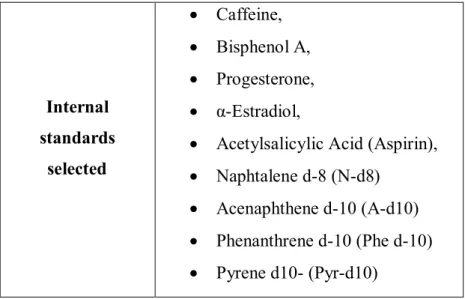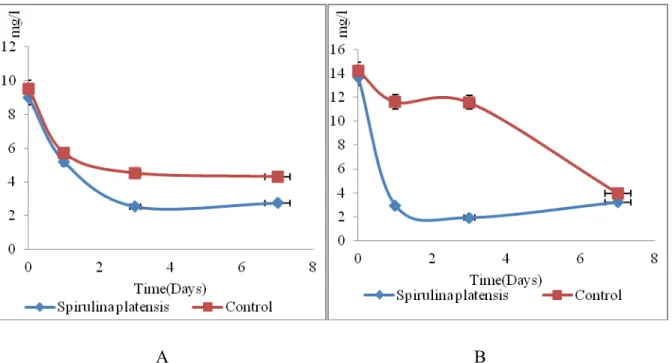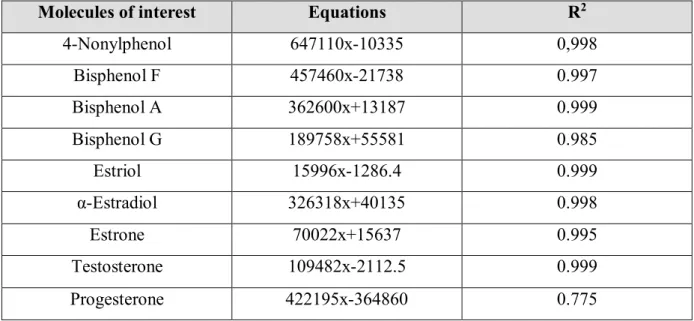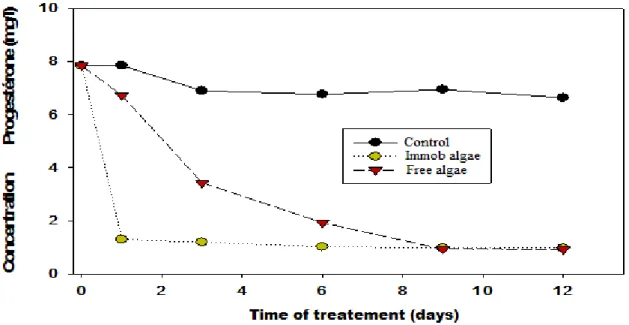Pépite | Interaction de certaines espèces d'algues et contaminants métalliques et organiques dans le milieu aquatique
Texte intégral
(2) Thèse de Tudor Popescu, Lille 1, 2016. 1|P a ge © 2016 Tous droits réservés.. lilliad.univ-lille.fr.
(3) Thèse de Tudor Popescu, Lille 1, 2016. 2|P a ge © 2016 Tous droits réservés.. lilliad.univ-lille.fr.
(4) Thèse de Tudor Popescu, Lille 1, 2016. 3|P a ge © 2016 Tous droits réservés.. lilliad.univ-lille.fr.
(5) Thèse de Tudor Popescu, Lille 1, 2016. REMERCIEMENTS. Je tiens tout d’abord à remercier au directeur de cette thèse, Pr. Baghdad OUDDANE professeur de l’Université Lille 1(France), pour la disponibilité de démarre cette thèse ainsi que pour sa confiance et ses encouragements durant la réalisation des travaux de recherche et la rédaction. Merci pour son soutien et ses conseils pendant ces années, ainsi que pour la disponibilité de m’accepte avec mes nombreuses questions. Merci pour la patience qu’il a prouvé et sa disponibilité de m’écoute. C’est grâce à sa volonté et indulgence qui m’a aidé arrivée à ce stade. Merci pour la grande liberté qu’il m’a accordé dans mes recherches, mais également pour m’apprendre les valeurs indispensables pour mener un travail de recherche jusqu’au bout. Merci également pour la disponibilité et l’encouragement de mettre en pratique cet travaille de recherche biologico-chimique grâce à cette thèse en cotutelle. Je n’oublierai jamais sa contribution pour ma famille ainsi que pour la bonne réussite de mes projets professionnels et personnels. Un grand merci au Pr. Victor SALARU, professeur de l’Université d’Etat Moldave, pour la codirection de ce travail, ainsi pour sa disponibilité de m’avoir accueil dans son équipe des écologues depuis mon première année d’Université et tout au long de ces dix dernières années. Je les remercie notamment pour les conseils, encouragement et le temps qu’ils m’ont accordé malgré leurs lourdes occupations. Je tiens aussi à exprimer ma gratitude et mes condoléances pour le départ d’entre nous du parent de l’algologie autochtone moldave, membre correspondent de l'Académie de Science Moldave, professeur émérite Vasile SALARU, qui m’a accepté dans son laboratoire et m’a donné la possibilité de démarre la thèse en étant aussi son codirecteur. Je suis également très reconnaissante envers Dr. Dobrojan Sergiu, Maître de conférences de l’Université d’Etat Moldave et Dr. Sopheak NET, Maître de conférences de l’Université Lille 1, pour leurs implications, leur disponibilité et leur accessibilité qu’ils ont su m’accorder a toute question apparue, pour les échanges constructifs qui m’ont permis d’avoir plus de confiance en moi dans la réalisation de mes travaux scientifiques.. 4|P a ge © 2016 Tous droits réservés.. lilliad.univ-lille.fr.
(6) Thèse de Tudor Popescu, Lille 1, 2016. Je présente mes remerciements aux membres de jury : Professeur. Yue GAO et Laurentia UNGUREANU d’avoir accepté de rapporter ce travail, ainsi qu’aux président de jury Pr. Martine LEERMAKERS et Pr. Moomen BAROUDI d’avoir accepté d’examiner ce travail. Je les remercie de leurs remarques et suggestions pour améliorer la qualité de ce travail. Je remercie également la commission européenne à travers le Projet ERASMUS MUNDUS IANUS I d’avoir finance ce travail ainsi qu’à Mme Véronique Level pour son soutien lors de mes démarches administratifs auprès de l’Université et de cet organisme de financement. Ce grâce a elle que je pu trouver Pr. Ouddane qui m’a encadré dans son équipe. Mes remerciements s’adressent également à l’équipe « physico-chimie de l’environnement » de m’avoir accueilli dans son laboratoire, Géosystèmes UMR 8217 et qui a rejoint le laboratoire LASIR UMR 8516 la 1 janvier 2015. Au sein du LASIR j’ai pu mener à bien et dans de meilleures conditions tous mes travaux de recherche. Je remercie également Dr. David DUMOULIN, ingénieur de recherche à l’Université Lille 1, et Roumain DESCAMPS pour leurs nombreuses interventions en matière de fonctionnement de matériels au laboratoire et pour leur volonté de m’apprendre le fonctionnement du parc analytique me permettant de travailler dans de bonnes conditions. Un grand merci également aux algologues du laboratoire Algologie, de l’Université d’Etat Moldave, notamment Mme Trofim Alina et Donţu Natalia pour m’avoir bien gardé les espèces des algues bleu-vertes et pour les nombreuse conseilles lors d’élevage algale. Je tienne à remercie notamment Mme Christine GRARE et Véronique ALAIMO les personnels techniques du laboratoire de l’Université Lille1, pour m’avoir bien approvisionné avec des produits chimiques et consommables et pour m’avoir bien aidé au lavage de la verrerie laquelle n’étais pas facile. Un grand merci aussi à mes collègues de bureau, asses nombreuses dans le temps, qui ont toujours été sympathiques avec moi et avec qui on a fait l’atmosphère agréable. Je pense ici à Oscar, Sofien, Eric, Julien, et la longue liste des stagiaires qui sont passe par le, bureau du chef, ainsi qu’à mes collègues Pratima et Anastasia.. 5|P a ge © 2016 Tous droits réservés.. lilliad.univ-lille.fr.
(7) Thèse de Tudor Popescu, Lille 1, 2016. Je tiens à remercier aussi le professeur émérite M. Michel WARTEL. Merci pour ses conseils scientifiques, toujours parfaits, sa gentillesse et sa disponibilité d’aide permanente et son insatiable envie de communique : ... alors... ça marche les manips !!!... ? Je remercie également Mme Catherine OUDDANE et Myriam WASTIAUX pour leur accueil chaleureux et leur gentillesse inégalée. Merci encore pour la soutenance dans les moments d’incertitude et d’hésitation. Merci à Mme Catherine pour ses conseils et sa disponibilité de m’écoute dans les moments difficiles et de joie et ses qualités humaines qui en font d’elle une personne que j’estime profondément. Merci à tous les permanents, Gabriel BILLON, Justine CRIQUET, Ludovic LESVEN et M. Abdel Boughriet pour les échanges scientifiques enrichissants et les soutiens. Je tiens aussi à remercier les docteurs et les futurs docteurs : Mirna, Racha, Pierre Jean, Eric, Oscar, Anastasia, Inès, Rafika, Chaza, Bouchra, Pratima ainsi que tous les stagiaires parmi lesquelles Nelea, Salma et Belvia qui m’ont accompagné durant ces trois années de thèses. Je tiens à remercier plus particulièrement ma demie âme, mon épouse Nelea, qui était toujours là pour partager avec moi tant la joie que le stress et qui m’a toujours soutenu et ne cesse de croire en moi quoi qu’il arrive ainsi que pour le plus cher cadeau ma belle fille Théodora. J’exprime mes sincères remerciements à toute ma famille à Moldavie qui m’a toujours soutenu et a su me faire confiance pendant les moments important de ma vie et merci à tous ceux qui ont participé de près ou de loin à la réalisation de ce travail.. A ma petite fille .... 6|P a ge © 2016 Tous droits réservés.. lilliad.univ-lille.fr.
(8) Thèse de Tudor Popescu, Lille 1, 2016. SOMMAIRE List of figures…………………………………………………………………………………16 List of tables…………………………………………………………………………………..20 Glossary………………………………………………………………………………………22 Résumé……………………………………………………………………………………..…24 Abstract (Română)……………………………………………………………………………25 Abstract (English)………………...…………………………………………………………..26 INTRODUCTION……….………………………………………………………….……..…28 Study Objectives………………………………….…………………………………….…….31 CHAPTER I. MICROALGAE. CYANOPHYTES………………………………………..…32 I.1. General characteristics of blue-green algae. Cyanophytes.…….………..………..36 I.1.1. Cyanobacterial water flowers ……………………….…………………….........37 I.1.2. Characteristics of blue-green algae used…………………………………..……38 I.1.2.1. Name of the strain of the species…………………………………...………...38 I.1.2.2. Entitled attributed to the strain of the applicant ……………………………..38 I.1.2.3. Origin of strains…………………………….………………………………...38 I.1.2.4. Morphological and cultural characteristics of stem…………………….…….39 I.1.2.5. The physiological and biochemical products synthesized by the strains ……40 I.1.2.6. The field of application of the strains………………………...........................40 I.1.2.7. The strains production parameters…………………………............................41 I.1.2.8. The method for determining the strains reproductive activity……….……….41 I.1.2.9. Cultivation media for breeding blue-green algae. Conditions and components of algae culture medium…………………………….………………………...41 I.1.3. Algal metabolites ………………………………………………………………42 I.1.4. Algal toxins……………………………………………………………………..44. 7|P a ge © 2016 Tous droits réservés.. lilliad.univ-lille.fr.
(9) Thèse de Tudor Popescu, Lille 1, 2016. I.1.4.1. Identity of cyanobacterial toxins……………………………………………...45 I.1.5. Preventing of blue-green algae blooms in the freshwater bodies……………....46 CHAPTER II. MATERIALS AND METHODS…………………………………………….48 II.1. Laboratory presentation…………………………………………………………………52 II.2. Algae cultivation. ……………………………………………………………………….52 II.2.1. The necessity to cultivate cyanobacteria……………………………………....52 II.2.2. Arguments of algae cultivation…………………………………………..…….53 II.2.3. General characteristic of algae cultivation…………………………………….54 II.2.4. Methods of algae cultivation. General characteristic of methods of algae cultivation..56 II.2.4.1. Regular cultivation..........................................................................................56 II.2.4.2. Periodic cultivation in depth...........................................................................56 II.2.4.3. Regular longtherm cultivation.........................................................................57 II.2.4.4. Multicyclic cultivation.....................................................................................57 II.2.4.5. Semi-continuous cultivation............................................................................58 II.2.4.6. Continued cultivation......................................................................................58 II.2.4.7. Synchronized cultivation.................................................................................59 II.2.4.8. Intensive Algae Cultivation.............................................................................59 II.3. Algae cultivation……………………………………………………………………...…60 II.3.1. Algae growth on different types of nutrient media…………………………………………………………………….…….……...60 II.3.2. Controlled algae growth stages…………………………………..………….…62 II.3.3. Preparation of blue-green algal innoculum……………………………………63 II.3.4. Amount of inoculums ………………………………………………………...63 II.3.5. Obtaining of algae pure cultures…… …………………………………………64. 8|P a ge © 2016 Tous droits réservés.. lilliad.univ-lille.fr.
(10) Thèse de Tudor Popescu, Lille 1, 2016. II.3.5.1. Obtaining of algae pure cultures using antibiotics…………………………..64 II.3.5.2. The use of filtration techniques for removal of bacteria from algal cultures…………………………………………………………………………….….65 II.3.5.3. The use of chemical methods for obtaining axenical algal cultures…………65 II.3.5.4. The use of agar media inoculation techniques for removal of bacteria from algal cultures………………………………………………………………………….65 II.3.5.5. The use of UV light………………………………………………………….65 II.3.5.6. The use of ultrasounds……………………………………………………….66 II.3.6. Nutrient media for algae cultivation…………………………………………………...67 II.4. The environemental conditions for algae cultivation……………………………………68 II.4.1.Light………………………………………………….…………………………69 II.4.2.Turbidity………………………………………………………………………..69 II.4.3. pH (Hydrogen Potential)……………………………………………………….69 II.5. Macro and micro-elements in nutrient media for algae cultivation. The importance of trace elements contents for algae cultivation………………………………………………....70 II.5.1. Calcium………………………………………………………………………..70 II.5.2. Magnesium…………………………………………………………………….71 II.5.3. Potassium………………………………………………………………………71 II.5.4. Chloride………………………………………………………………………..72 II.5.5. Sodium………………………………………………………………………....72 II.5.6. Sulfur…………………………………………………………….…………….72 II.5.7. Iron……………………………………………………………………………73 II.5.8. Nitrogen……………………………………………………………………….74 II.5.9. Phosphorus……………………………………………………………………..74 II.5.10. Oxygen…………………………………………………………………..……75 9|P a ge © 2016 Tous droits réservés.. lilliad.univ-lille.fr.
(11) Thèse de Tudor Popescu, Lille 1, 2016. II.5.11. The Carbon content in the algae medium…………………………………….75 II.6. Conditions of medium in algae cultivation……………………………………………..75 II.6.1. Nutrient concentrations in algae cultivation…………………………………...75 II.6.2. Nutrient ratio in the algae medium…………………………………………….76 II.6.3. Organic compounds in the algae medium……………………………………..76 II.6.4. Temperature of the algae medium……………………………………………..77 II.6.5. Floatability of algae in the medium……………………………………………77 II.6.6. Mixing of the algae medium………………………………………………...…78 II.6.7. Artificial chelating agents in the algae medium…………………………….…78 II.7. Algal productivity……………………………………………………………………..…78 II.8. Forms of algae utilization in biotechnology applications. Algae immobilization.………79 II.8.1. Definition and necessity of algae immobilization……………………...….......79 II.8.2. Methods of blue-green algae immobilization………………………………….79 II.8.3. The blue-green algae entrapment in Na-alginate matrix. Preparation of Spirulina platensis algae-alginate beads………………………………………………………...81 II.9. Organic micro-pollutants detection………………………………………………….......82 II.9.1. Sample Processing……………………………………………………………..82 II.9.2. Filtration……………………………………………………………………….83 II.9.3. Extraction of the dissolved phase. Liquid-Liquid extraction (LLE)………..83 II.9.4. The method of internal standards………………………….…………………..84 II.9.5. Accelerated solvent extraction (ASE)…………………………………………85 II.9.6. Purification………………………………………………………………….....87 II.9.7. Chromatographic analysis……………………………………………………..87 II.9.8. Data Processing……………………………………………………………….88. 10 | P a g e © 2016 Tous droits réservés.. lilliad.univ-lille.fr.
(12) Thèse de Tudor Popescu, Lille 1, 2016. II.10. Mineral micropolluants detection………………………………………………….......89 II.10.1. General methods of major and trace metals elements analysis in aquatic environment…………………………………………………………………..89 II.10.2. The ICP-AES…………………………………………………………...….....92 II.10.3. The ICP-MS…………………………………………………………………..92 II.10.4. Major and trace metals elements analysis. Preparation of diluting solution 2% HNO3………………………………………………………………………................93 II.10.5. Calibration……………………………………………………………….……93 II.10.6. The Dissolved Organic Carbon……………………………………………….93 II.10.7. The analytical methods of anions analysis. Ionic chromatography……..........94 CHAPTER III. POLLUTANTS IN THE AQUATIC ENVIRONMENT……….…………96 III. Main micro-pollutants in the environnement. Definition and classification of micro-pollutants………………………………………………………………...…………...100 III.1. The mineral micro-pollutants. The macro and trace elements The metals…………………………………………………………………………...100 III.1.1. Heavy metals in the aquatic environment…………………………………...101 III.1.2. Toxicity of heavy metals…………………………………………………….103 III.1.3. Toxicity of cadmium (Cd)……………………………………………….…..104 III.1.4. Bioremediation of heavy metals (ETM)……………………………………..105 III.1.4.1. Phycoremediation of heavy metals (ETM)………………………………..106 III.1.5. Speciation……………………………………………………….………..….108 III.2. Wastewaters and their discharge in water courses……………………………….…...109 III.2.1. Wastewaters and their discharge in water courses of Republic of Moldova………………………………………………………………...110 III.2.2. The nutrients in micro-algae cultivation on wastewaters……………………112 11 | P a g e © 2016 Tous droits réservés.. lilliad.univ-lille.fr.
(13) Thèse de Tudor Popescu, Lille 1, 2016. III.3. Organic micro-pollutants in the environment. Persistent organic pollutants or POPs ……..……………………………………………………………………………………..….114 III.3.1. Pharmaceuticals products……………………………………………………115 III.3.2. The antibiotics……………………………………………………………….116 III.3.3. The hormones……………………………………………………….……….117 III.3.4. Bisphenols……………………………………………………………….…..117 III.3.5. PAH’s……………………………………………………………………………….119 III.3.5.1. Fluorene……………………………………………………………………119 III.3.5.2. Phenantrene……………………………………………………………......120 III.3.5.3. Pyrene……………………………………………………………………...120 III.3.5.4. Fluoranthene…………………………………………………..…….….....120 III.3.6. Sources and behavior of organic micro-pollutants in the environment…….……….121 CHAPTER IV. INTERACTION OF CERTAIN ALGAE SPECIES WITH METALLIC AND ORGANIC CONTAMINANTS…………………………………………………………….124 IV.1. Bioremediation of organic micro-pollutants by blue-green algae……...….………….128 IV.1.1. Bioremediation of phthalates, bisphenol and residues of drugs by Spirulina platensis blue-green…………………………....................................….....................128 IV.1.2. Bioremediation of HAP contaminated waters from urban wastewater treatment plant by Nostoc gelatinosum blue green-algae …………….…..…………130 IV.1.2.1. Chemicals and reagents…...............................................……………….......130 IV.1.2.2.. Growth. conditions…………………………………...…………………130. IV.1.2.3. Batch biosorption studies of Nostoc gelatinosum in PAH contaminated waters………………………………………………………………………………....130 IV.2. Trace metal elements (ETM) in wastewaters. Seasonal campaigns of trace metal elements sampling and analysis in the waters of the Dniester River and Bic, the most strategic economic sites of Republic of Moldova………………………………………………….…131 12 | P a g e © 2016 Tous droits réservés.. lilliad.univ-lille.fr.
(14) Thèse de Tudor Popescu, Lille 1, 2016. III.2.1. Seasonal campaigns of Dissolved Organic Carbon (DOC) analysis in the waters of the Dniester River and Bic………………………………………………………..134 IV.3. Blue-green algae growth…………......…….………………………………….134 IV.3.1. Bioremediation of anionic micro-pollutants from WWTP in batch by blue-green Nostoc gelatinosum algae…………………………………………………………………....135 IV.3.2. Prepare of the inoculums………………………………………………………........135 IV.3.3. Preparation of dishes………………………………………………………………...136 IV.3.4. Organism, culture and growth conditions…………………………………….……..136 IV.3.5. Determination of Algal Productivity……………………………………………......137 IV.3.6. Effects of pH on bio sorption of Macronutrients and ETM…………………………138 IV.3.7. Analytical methods of anions analysis ………………………………………………..…139 IV.3.7.1. Sulfur………………………………………………………….….………..140 IV.3.7.2. Chlorides…………………………………………………………………..140 IV.3.7.3. Nitrogen……………………………………………………………….…..141 IV.3.7.4.Phosphorus…………………………………………………………………142 IV.3.7.5. Studies of biosorption of cadmium (II) in batch…………………….…….143 IV.4. Bioremediation of Anionic macro-pollutants by algae in free and immobilized state in regular growth conditions…………………………………………………...145 IV.4.1. Bioremediation of macro elements (anions) by the blue-green algae Spirulina platensis in regular grown in diluted wastewaters from livestock complex……………..….145 IV.4.1.1. Preparation of media with the addition of waste water used in the cultivation of Spirulina platensis …………………………………………………………………….....145 IV.4.1.2. Regular grown of Spirulina platensis on media with the addition of livestock (from sheep’s) wastewaters…………………………………………………...….….145 IV.4.1.3. Regular grown of Spirulina platensis on media with the addition of livestock (pony) wastewaters………………………………………………………………..…145. 13 | P a g e © 2016 Tous droits réservés.. lilliad.univ-lille.fr.
(15) Thèse de Tudor Popescu, Lille 1, 2016. IV.4.2. Bioremediation of macro elements (anions) by the xanthophylls algae Tribonema viride in regular grown in the filtered non-dilute wastewater from entering of Chisinau, Republic of Moldova treatment plant……………………………………………………….149 IV.5. Bioremediation of Organic micro-pollutants by blue-green algae in free and immobilized state………………………………………………………………………...….155 IV.5.1. Bioremediation of pharmaceutical products (medicaments and hormones) by blue-green algae Spirulina platensis……………………………………………………....155 IV.5.2. Bioremediation of PAH’s by blue-green algae Nostoc gelatinosum in two types of medium (wastewater and synthetic medium)…………………………………….161 IV.6. Metals analysis. Adsorption in function of pH medium………………………….…...164 IV.6.1. Effects of pH on biosorption of Macronutrients and ETM……….…….…...164 IV.6.2. Preparation of Spirulina platensis algae-alginate beads………………….…165 IV.6.3. Preparation of cadmium II solutions for biosorption…………………...…...165 IV.6.4. The preparation of pH buffer solutions……………………………………...165 IV.6.5. Experience with Spirulina platensis blue-green algae in a wide of pH ranges………………………………………………………………................166 IV.6.6. Metal Desorption and Biosorbent Reactivation………………………..........166 IV.6.7. Analysis of Macro-elements and ETM in the wastewater. Analysis of Cadmium II ions…………………………………………………………………..…167 IV.6.7.1. Effect of pH on cadmium (II) biosorption………………………………...167 IV.6.7.2. Effect of pH on Magnesium biosorption…………………………………..170 IV.6.7.3. Effect of pH on Zinc biosorption………………………………………….170 IV.6.7.4. Effect of pH on Calcium biosorption………………………...……………171 IV.6.7.5. Effect of pH on Cuivre biosorption………………………………………..172 IV.6.7.6. Effect of pH on Iron biosorption………………………………………….173. 14 | P a g e © 2016 Tous droits réservés.. lilliad.univ-lille.fr.
(16) Thèse de Tudor Popescu, Lille 1, 2016. IV.6.7.7. Effect of pH on Sodium biosorption………………………………………175 Conclusion and perspectives……………………………………….………………..178 BIBLIOGRAPHY.......................................................................................................182 ANNEXES...................................................................................................................197. 15 | P a g e © 2016 Tous droits réservés.. lilliad.univ-lille.fr.
(17) Thèse de Tudor Popescu, Lille 1, 2016. List of Figures Fig.1.1. Cyanobacterial water flowers ………………………………………………………30 Fig.1.2.(A) Cylindrospermum licheniforme (Bory) Kütz, (B) Nostoc gelatinosum (Schousb) Elenk and (C) Spirulina platensis (Nordst.) Geitl. CAUSM. 26……………….………….……...31 Fig.2.1. Generals stages of algae cultivation…………………………………………………46 Fig.2.2. Stages of the nutrients consumption during growth of algae biomass………………60 Fig.2.3. The productivity of Nostoc gelatinosum in a growth medium of un-diluted wastewater…………………………………………………………………………………….71 Fig.2.4. The immobilization process of Nostoc gelatinosum blue green algae in Na-alginate beads…………………………………………………………………………………………..76 Fig.2.5 Separation funnels during the LLE extraction………………………………………..77 Fig.2.6. Simplified diagram of ESA, an actual photo and membership of an ASE cell……...78 Fig.2.7. A photo of the GC-MS apparatus Varian 3900-coupled to a mass spectrometer (MS, Saturn 2000, Varian, USA) used for various analyzes……………………………………….79 Fig. 2.8. Model ICP-AES (Varian Vista Pro) with its heating flame argon plasma at 6000K.84 Fig.2.9. Shimadzu TOC meter (TOC-V CSH model)……………………………………...…86 Fig.2.10. Ionic exchange chromatography Dionex EG 50 system and their operational principles……………………………………………………………………………………...87 Fig.3.1. Physical map of rivers in Republic of Moldova……………………………………102 Fig.3.2. Different drug diffusion paths in the water cycle……………………………..……107 Fig.3.3. The different sources of contamination by organic micro-polluants……………….113 Fig.4.1. Preparation of various environments for bioremediation by Spirulina platensis…..118 Fig.4.2. Heavy metals concentrations in surface wastes of Republic of Moldova………….121 Fig.4.3. Dissolved Organic Carbon concentrations in water of rivers Bic and Dniester……122 Fig.4.4. The regular cultivation method of Nostoc gelatinosum blue-green algae to undiluted wastewater from the exit of treatment plant in laboratory conditions………………………123 Fig.4.5. Nostoc gelatinosum blue-green algae productivity on the WWTP un-diluted medium………………………………………………………………………………………126 Fig.4.6. Evolution of pH in non-diluted wastewater growth media of Nostoc gelatinosum blue-green algae in batch……………………………………………………………………127 Fig.4.7. Linear regression for the experimental analyzed anions……………………………127 Fig.4.8. Evolution of sulfate consumption by the culture of blue-green algae Nostoc 16 | P a g e © 2016 Tous droits réservés.. lilliad.univ-lille.fr.
(18) Thèse de Tudor Popescu, Lille 1, 2016. gelatinosum in non-diluted wastewater treatment plant Villeneuve d'Ascq, France………..128 Fig.4.9. Evolution of consumption of chloride by the culture of blue-green algae Nostoc gelatinosum in non-diluted wastewater treatment plant Villeneuve d'Ascq………………...129 Fig.4.10. Evolution of nitrate consumption by the culture of blue-green algae Nostoc gelatinosum in non-diluted wastewater from Villeneuve d'Ascq, France treatment plant….130 Fig.4.11. Evolution of consumption of phosphates by the culture of blue-green algae Nostoc gelatinosum in non-diluted wastewater treatment plant Villeneuve d'Ascq………………..131 Fig.4.12. Biosorption study of cadmium in a batch system…………………………………132 Fig. 4.13. Evolution of Cl- ion concentration in media with the addition of livestock (pony) wastewaters under the influence of algae Spirulina platensis (A - 2%, B - 5% diluted wastewater)………………………………………………………………………………….135 Fig.4.14. Evolution of NO3- ion concentration in media with the addition of livestock (pony) wastewaters under the influence of algae Spirulina platensis (A - 2%, B - 5% diluted wastewater)………………………………………………………………………………….136 Fig.4.15. Evolution of PO43- ion concentration from media with the addition of livestock (pony) wastewaters treated by blue-green Spirulina platensis algae (A - 2%, B - 5% diluted wastewater)………………………………………………………………………………….137 Fig.4.16. Tribonema viride Pasch…………………………………………………………...138 Fig.4.17. Evolution of ADB of Tribonema viride over a 3 days of cultivation in wastewater culture medium from Chisinau (Republic of Moldova) wastewater treatment plant or poultry complexes………………………………………………………………………………........139 Fig.4.18. Evolution of NO3 - in non-diluted wastewater medium from wastewater treatment plant treated by Tribonema viride………………………………………………………………… 140 Fig.4.19. Evolution of NH4+ ion concentration in non-diluted wastewater medium from wastewater treatment plant treated by Tribonema viride………………………………………..141 Fig.4.20. Evolution of PO43- ion concentration in non-diluted wastewater medium from Chisinau wastewater treatment plant treated by Tribonema viride…………………………….141 Fig.4.21. Evolution of TDS in non-diluted wastewater medium from wastewater treatment plant treated by Tribonema viride…………………………………………………………………..142 Fig.4.22. Evolution of HCO3 - ions in non-diluted wastewater medium from wastewater treatment plant treated by Tribonema viride………………………………………………………143 Fig 4.23. Testosterone calibration curve…………………………………………………….144. 17 | P a g e © 2016 Tous droits réservés.. lilliad.univ-lille.fr.
(19) Thèse de Tudor Popescu, Lille 1, 2016. Fig.4.24. pH of solutions in bioremediation studies of pharmaceutical products (medicaments and hormones) by blue-green algae Spirulina platensis…………………………………………146 Fig.4.25. Progesterone elimination by free and immobilized in Na-alginate blue-green algae Spirulina platensis strain in Zarrouk medium………………………………………………146 Fig.4.26. Removal of Bisphenol A (A), Bisphenol E(B), Bisphenol F(C) and Bisphenol G (D) by free and immobilized in Na-alginate blue-green algae Spirulina platensis strain in Zarrouk medium………………………………………………………………………………………148 Fig.4.27. Removal of Estriol by free and immobilized in Na-alginate blue-green algae Spirulina platensis strain in Zarrouk medium……………………………………………….149 Fig.4.28. Removal of Testosterone by free and immobilized in Na-alginate blue-green algae Spirulina platensis strain in Zarrouk medium……………………………………………….149 Fig.4.29. Removal of Alpha-Estradiol by free and immobilized in Na-alginate blue-green algae Spirulina platensis strain in Zarrouk medium………………………………………...150 Fig.4.30. Comparison of the 4 PAHs removal using 100% treated wastewater (A, B) and Drew (C) as algal medium…………………………………………………………………..152 Fig.4.31. The percentile of the PAHs remaining in the medium during the 22 days of incubation……………………………………………………………………………………152 Fig.4.32. Evolution of pH values in cycle I (A) and cycle II after regeneration (B) in the presence of blue-green algae Spirulina platensis immobilized in Na-alginate for the fives analyzed solutions…………………………………………………………………………...157 Fig.4.33. Evolution of cadmium ions concentration in cycle I (A) and cycle II after regeneration (B) in the presence of blue-green algae Spirulina platensis immobilized in Naalginate for all 5 pH analyzed solutions……………………………………………………..158 Fig.4.34. Evolution of magnesium (Mg) concentration in two cycles of natural pH wastewater solution(A), cycle I(B) and cycle II(c) for four pH synthetic solutions, contaminated with 50 µg/L of cadmium, in presence of fresh blue-green algae Spirulina platensis immobilized in Na-alginate…………………………………………………………………………………..159 Fig.4.35. Evolution of zinc(Zn) concentration in two cycles of natural pH wastewater solution(A), cycle I(B) and cycle II(C) for four pH synthetic solutions, contaminated with 50 µg/L of cadmium, in presence of fresh blue-green algae Spirulina platensis immobilized in Na-alginate…………………………………………………………………………………..160. 18 | P a g e © 2016 Tous droits réservés.. lilliad.univ-lille.fr.
(20) Thèse de Tudor Popescu, Lille 1, 2016. Fig.4.36. Evolution of calcium concentration in natural pH wastewater samples for two cycles (A); cycle I(B) and cycle II (C) are the synthetic pH solutions in presence of blue-green algae Spirulina platensis immobilized in Na-alginate of four pH analyzed solutions…………….161 Fig.4.37. Evolution of copper ions concentration in cycle I and II for natural pH wastewater(A), cycle I(B) and cycle II(C) for four synthetic pH solutions, contaminated with 50µg/L of cadmium, in presence of fresh blue-green algae Spirulina platensis immobilized in Na-alginate…………………………………………………………………………………..162 Fig.4.38. Evolution of iron (Fe) concentration in cycle I(A) and II(B) for synthetic pH solutions and natural pH of wastewater solution(C), contaminated with 50µg/L of cadmium, in presence of fresh blue-green algae Spirulina platensis immobilized in Na-alginate……..163 Fig.4.39. Evolution of manganese(A), potassium(B) and silicon(C) concentration in two regeneration cycles of natural wastewater solution at natural pH solutions, contaminated with 50 µg/L of cadmium, in presence of fresh blue-green algae Spirulina platensis immobilized in Na-alginate…………………………………………………………………………………..164 Fig.4.40. Evolution of sodium(Na) concentration in two cycles of natural pH wastewater solution(A), cycle I(B) and cycle II(c) for four pH synthetic solutions, contaminated with 50µg/L of cadmium, in presence of fresh blue-green algae Spirulina platensis immobilized in Na-alginate…………………………………………………………………………………..165. 19 | P a g e © 2016 Tous droits réservés.. lilliad.univ-lille.fr.
(21) Thèse de Tudor Popescu, Lille 1, 2016. List of Tables Table 2.1. The different internal standards used……………………………………………...76 Table 2.2. General methods of chemical analysis of trace metal elements from polluted waters…………………………………………………………………………………………82 Table 3.1. Limits to not be exceeded for trace elements according to the (CODEX standards Codex Standard August 1, 1981 amended in June 1981, July 2001 and February 2008 Natural mineral waters.)……………………………………………………………………………….94 Table 3.2.Some of the most toxic heavy metals and their actions on the body………………95 Table 3.3. The physicochemical properties of Bisphenols and 4 nano-phenol studied…..…109 Table 4.1. Internal standards selected for the feasibility study by Spirulina platensis…...…118 Table 4.2. Batch experiment details of Nostoc gelatinosum blue-green algae ………….…120 Table 4.3. Equations of the calibration line for a few molecules of interest with their studied R2 correlation coefficients…………………………………………………………………...145. 20 | P a g e © 2016 Tous droits réservés.. lilliad.univ-lille.fr.
(22) Thèse de Tudor Popescu, Lille 1, 2016. 21 | P a g e © 2016 Tous droits réservés.. lilliad.univ-lille.fr.
(23) Thèse de Tudor Popescu, Lille 1, 2016. Glossary AAS: Atomic Absorption Spectroscopy ADB: Biomass Absolute Dried ADN: Deoxyribonucleic acid ASE: Accelerated Solvent Extraction ASV: Anodic Stripping Voltametry ATP: Adenosine Triphosphate BPA: Bisphenol A CCD: Charge Coupled Device COD: Dissolved Organic Carbon CTC: Collision Cell Technology method DCIPH2: Dichlorophenolindophenol DL - Detection Limit EDTA: Ethylenediaminetetraacetic acid ETM: Metal Trace Element FS: Full Scan mode GC: Gas Chromatography GC-MS: Gas chromatography - mass spectrometry HAB: Harmful Algal Blooms HPLC: High Performance Liquid Chromatography ICP-AES: Inductively Coupled Plasma-Atomic Emission Spectrometry ICP-MS: Inductively Coupled Plasma-Mass Spectrometry LLE: Liquid-Liquid extraction MRM: Multiple Residual Monitoring MS: Mass Spectrometry 22 | P a g e © 2016 Tous droits réservés.. lilliad.univ-lille.fr.
(24) Thèse de Tudor Popescu, Lille 1, 2016. NAD+: Nicotinamide adenine dinucleotide NADP+: Nicotinamide adenine dinucleotide phosphate NTA: Aminopolycarboxylic acid PAH: Polycyclic Aromatic Hydrocarbon PHA: Polyhydroxyalkanoates POP: Persistants Organic Polluants RPS: Exocellular polysaccharides SIS: Selected Ion Storage SSM: Suspended Solid Matter TDS: Fixed residue UV: Ultra-Violet WWTP: Wastewater Treatment Plant. 23 | P a g e © 2016 Tous droits réservés.. lilliad.univ-lille.fr.
(25) Thèse de Tudor Popescu, Lille 1, 2016. Résumé La révolution industrielle et technologique avec l'urbanisation intensive, la croissance démographique a attiré l'attention de l'humanité pour la nécessité d’adopter le développement durable pour préserver l’environnement. Chimisation intense de l'agriculture et des processus industriels, l'augmentation de l’exploitation minière, le traitement des ressources minérales incomplètes ensemble avec le développement des transports, l'infrastructure routière, les services et l’augmentation de la consommation médicaments conduit à la pollution émergente des écosystèmes avec diverses micropolluants minéraux, organique et organométallique extrêmement toxique. Les polluants organiques (persistants, produits pharmaceutiques, hormones et bisphénols) ainsi que le polluants minéraux (métaux lourds et sel minéraux) sont susceptibles de développer une toxicité non négligeable pour la santé humaine et le bon fonctionnement de l’écosystème global, y compris l’atmosphère, les ressources en eaux, les sols, les sédiments et les biotes. Une de plus mobile phase, celle aquatique est et exposé le plus a la pollution conduisant à de graves problèmes environnementaux. C’est un danger très important pour l’humanité, menaçant la destruction des bassins d'eau de la biosphère avec des conséquences importantes dans l'approvisionnement en eau et influence directe dans la sante de la population. Les volumes des eaux usées restent croissants et continuent d’augmenter de façon permanente. Afin de remédier la situation actuelle de l'eau de surface, il est nécessaire d'isoler ces substances toxiques de l'eau et en soumettant ces dernières au processus de traitement, le retourné plus tard être au circuit. Dans le présent travail, on s’intéresse à la bioremédiation des polluants organique et minéraux dessus mentionnées par les algues bleu vertes. La première partie de la thèse: ,,Interaction de certaines espèces d'algues et contaminants métalliques et organiques dans le milieu aquatique,, est consacrée à la caractérisation des souches algales utilisées suivi de méthodes de l’élevage algale en laboratoire pour la production de la biomasse au moindre cout prête pour les processus de bioremédiation des micropolluants. L’élevage des espèces algale sur milieux culturelles provenant des stations de traitement des eaux non-diluées va nous offrir un double avantage : traitement tertiaire des effluents ainsi que milieux gratuits pour l’élevage algale. Une seconde partie consacre à la méthode de bioaccumulation des polluants organiques et minéraux sur la phase solide algale libre tant qu’en forme immobilisée avec l’évaluation de consommation et dégradation des micropolluants polluants Mots clés : Eau, contamination, micropolluants, bioremédiation, algues bleu-vertes.. 24 | P a g e © 2016 Tous droits réservés.. lilliad.univ-lille.fr.
(26) Thèse de Tudor Popescu, Lille 1, 2016. Abstract (Română) Revoluţia industrială și tehnologică împreună cu creșterea demografică și urbanizarea intensivă au atras atenția omenirii asupra necesitătii conservării si dezvoltării durabile a mediului ambiant. Chimizarea intensă a agriculturii și a proceselor industriale, creșterea extracției miniere si procesarea incompletă a resurselor minerale împreună cu dezvoltarea transporturilor, infrastructurii drumurilor, serviciilor și consumului medicamentos a dus la poluarea emergentă a ecosistemelor cu micropoluanți minerali, organici și organo-metalici extrem de toxici. Poluanții organici persistenți, produsele farmaceutice, bisfenolii și hormonii precum și micropoluanții minerali (metale grele și săruri minerale) sunt susceptibile de a dezvolta o toxicitate semnificativă pentru sănătatea umană și pentru buna funcționare a ecosistemului global, inclusiv atmosfera, resursele de apă, soluri, sedimente și biota. Cea mai expusă si mobilă fază care este expusă poluării este cea acvatică ceea ce duce la grave probleme de mediu, distrugînd biocenozele bazinelor acvatice cu importante consecințe în aprovizionarea cu apă potabilă de calitate, influențînd direct sănatatea populației. Volumul apelor reziduale se menţine permanent la o cotă ridicată şi în continuă creştere. Pentru redresarea situaţiei actuale a apelor de suprafaţă este necesar de a izola aceste substanţe toxice din ape şi de a le supune proceselor de epurare, ca mai apoi să fie reîntoarse în circuit. În lucrarea de față, suntem interesați de bioremedierea poluanților organici și minerali menționați cu ajutorul alge verzi albastre. Prima parte a tezei: ,,Interactiunea unor specii de alge cu contaminantii metalici si organici in mediul acvatic,, este consacrată caracterizării tulpinilor algale utilizate, metodelor de producere în laborator a biomasei algale cu un sinecost ieftin pentru utilizarea ulterioară în procesele de bioremediere a micropoluanților. Creșterea speciilor de alge pe mediile culturale ale apelor nediluate la ieșirea din stațiile de epurare ne va oferi un dublu avantaj: tratarea terțiară a apelor reziduale, precum și mediu de cultură gratuit pentru cultivarea algelor. Cea de a doua parte a tezei este consacrată metodelor bioremedierii poluanților organici și minerali pe suport algal atît liber cît și în formă imobilizată. Studiul fost efectuat cu evaluarea degradării poluanților organici cît și evaluării consumului macro si microelementelor din mediu poluat. Cuvinte cheie: apă, contaminare, micropoluanți, bioremediere, algele albastre-verzi.. 25 | P a g e © 2016 Tous droits réservés.. lilliad.univ-lille.fr.
(27) Thèse de Tudor Popescu, Lille 1, 2016. Abstract (English) The industrial and technological revolutions, causing intensive urbanization and population growth, have drawn the attention of humanity onto the necessity for conservation and sustainable environment development. Intense use of chemicals in agricultural and industrial processes, increased mining, incomplete processing of mineral resources together with the development of transport, road infrastructure, services and the increase in drug consumption led to an emerging pollution of the ecosystems, infecting them with various minerals, organic and organo-metallic micropollutants which are extremely toxic. Organic pollutants (persistent, pharmaceuticals, hormones and bisphenols) and the mineral contaminants (heavy metals and mineral salts) are likely to cause significant damage to human health and the proper functioning of the global ecosystem, including the atmosphere, water resources, soils, sediments and biota. Water, being the most mobile phase, is the most exposed to pollution leading to serious environmental problems. This is a very significant threat to humanity, risking the destruction of global water basins, having important consequences on the water supply and a direct influence on population health. The volumes of wastewaters are increasing and continue to increase permanently. In order to remedy the present situation of the surface water, it is necessary to isolate these toxic substances from water and subject them to the treatment process so that, ultimately, to put them back in circuit. In the present work, we are interested in the bioremediation of organic and mineral pollutants mentioned above by the use of blue green algae. The first part of the PhD thesis: ,,Interaction of certain algae and metallic and organic contaminants in the aquatic environment,, is dedicated to the characterization of utilized algal strains, of the methods that were used for algal biomass production in the laboratory with a cheap prime cost biomass for future bioremediation processes of micropollutants. Growth of algal species on undiluted waters from the treatment plants will offer us a double advantage: third party treatment as well as free environment for algae farming. The second part of PhD thesis is dedicated to the characterization of bioaccumulation processes of organic and mineral pollutants on a free as well as an immobilized algal state, with the evaluation of consumer and degradation of micro-pollutants. Keywords: Water, contamination, micro, bioremediation, blue-green algae. 26 | P a g e © 2016 Tous droits réservés.. lilliad.univ-lille.fr.
(28) Thèse de Tudor Popescu, Lille 1, 2016. 27 | P a g e © 2016 Tous droits réservés.. lilliad.univ-lille.fr.
(29) Thèse de Tudor Popescu, Lille 1, 2016. INTRODUCTION. 28 | P a g e © 2016 Tous droits réservés.. lilliad.univ-lille.fr.
(30) Thèse de Tudor Popescu, Lille 1, 2016. 29 | P a g e © 2016 Tous droits réservés.. lilliad.univ-lille.fr.
(31) Thèse de Tudor Popescu, Lille 1, 2016. Water is an essential element of civilization. It is as the basis of large varieties of activities including water supply, irrigation, energy, industry, aquaculture, recreation, transportation. However, water resources can be polluted by various sources of pollution such as the industrial discharges, agricultural and urban runoff and municipal waste. For the protection of aquatic life, water pollution should be minimized or removed to satisfy the protection requirements of the European Water Framework Directive of 23 October 2000 adopted by the Council and European Parliament [3]. The contamination of aquatic ecosystems becomes more and more severe for some region. Among the most toxic contaminants, there are metal trace elements (ETM) or heavy metals. Human activities are largely responsible for the contamination of aquatic ecosystems by ETM. Indeed, these elements are presents in the runoff of agricultural soils containing plant protection products based on copper and arsenic, and effluent discharges. Three quarters of organic carbon in the waste water is present in the form of carbohydrates, fats, proteins, amino acids, and volatile acids [4]. The inorganic components contain high amount of sodium, calcium, potassium, magnesium, chloride, sulfate, phosphate, ammonium bicarbonate and heavy metals [5, 6]. This complex mixture of natural organic and inorganic materials and synthetic compounds can be treated with the blue-green algae. This fascinating idea was launched fifty-nine years ago in the United States by Oswald and Gotaas (1957) [7] and has since been extensively tested in many countries [8-10]. Bio-treatment with micro algae is particularly attractive thanks to the photosynthetic capacity responsible for the conversion of solar energy into useful energy from biomass via the consumption of nutrients in polluted waters. Blue-green algae are microorganisms that are part of the phytoplankton community of the aquatic environment. They are classified in the same group as bacteria, which are recognized as being more primitive algae. For this reason, the blue-green algae are also called "cyanobacteria". However, blue-green algae have common characteristics with algae, including pigments in their cells that allow photosynthesis. The term "blue-green" refers to their blue (phycocyanin) and green (chlorophyll) pigments, which dominate in most species.. 30 | P a g e © 2016 Tous droits réservés.. lilliad.univ-lille.fr.
Figure
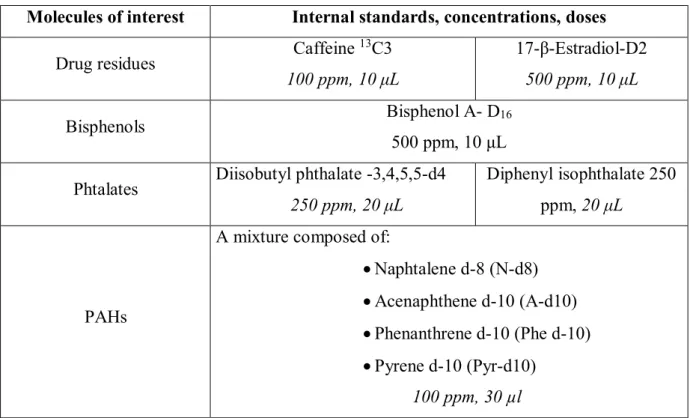

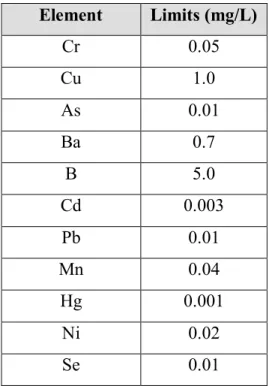

Documents relatifs
L’archive ouverte pluridisciplinaire HAL, est destinée au dépôt et à la diffusion de documents scientifiques de niveau recherche, publiés ou non, émanant des
[r]
Un modèle de spéciation a été utilisé pour simuler les mesures effectuées (Cd dissous et particulaire) lors de différentes campagnes réalisées dans les estuaires de la Seine, de la
Se développe sur différents types de milieux humides : - marais, plan d’eau, etc., jusqu’à trois mètres de profondeur - sol détrempé. Tolérante vis-à-vis de la qualité des eaux
trum a nd (b) near-normal incidence broadband optical refiect ance spec- trum collected from sample PSi4.13# 12, a binary periodic multilayered 1r-Si film wit h the lower
Aux pH inférieurs à 4, les ions divalents sont forte- ment retenus, R(Ca 2 +) ~ 90%, ce qui induit une rétention négative des co-ions monovalents pour compenser le déséquilibre
Les objectifs de cette étude sont de déterminer tout d’abord les perceptions des patients et parents concernant l’éducation à la transition, puis d’identifier
4 Potential impacts on particulate matter emissions of one person transportation over one km for WLTP cycle for midsize cars, present time, French and European
![Table 3.3. The physicochemical properties of Bisphenols and 4 nanophenol ([143], [141])](https://thumb-eu.123doks.com/thumbv2/123doknet/3707376.110299/119.892.131.764.145.1110/table-physicochemical-properties-bisphenols-nanophenol.webp)
